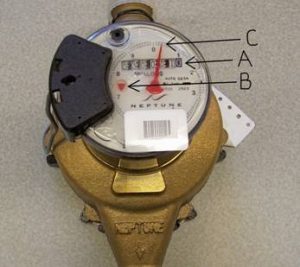 Finding and repairing water leaks is an important part of water conservation.
Finding and repairing water leaks is an important part of water conservation.
If your meter is located in a locked vault, DO NOT attempt to open it yourself. Call (516) 931-6469 and arrange to have a technician check your meter for leaks. An appointment can be scheduled for a time when you are either at home or at work.
If your meter is located in your basement, follow the steps below:
- Turn off all the taps in your house and do not use any water. Use one of the following two techniques to check for leaks.
- Use the “Low Flow Indicator” labeled “B” in the picture. If the Low Flow Indicator is moving and no water is being used in your home, this is an indication that there is a leak on your side of the meter.
- Use “Test Dial” labeled “C” in the picture. Note the position of the dial. Recheck the position in 30 minutes. If it has moved and no water has been used in your home between the times you first checked and when you checked later, then there is a leak on your side of the meter.
Fixing Leaks
Indoor Leaks:
- Keep the phone number of a licensed plumber on hand for emergencies.
- Know the location of the main valve.
- It is also important to know the integrity of the main valve. For example, if the main valve is the original valve it may be wise to have a licensed plumber inspect it to determine its integrity and if it is necessary to replace it.
Toilet Tank Leaks:
- Most toilet leaks are silent. However, if you hear water running or flushing when the toilet is not in use, this is a sign of a leak.
- You can determine if your toilet is leaking by putting several drops of food coloring into the tank of your toilet. Wait 10 minutes and look into the bowl. If there is color in the water then your toilet has a leak.
- A toilet leak may be due to a bad flapper or a “fill valve” that will not shut off.
- You can fix a fill valve problem:
-
- Adjust the water level lower.
- Get the fill valve to shut off.
- If neither of these procedures works, the fill valve must be replaced.
- Replacing a bad flapper: If during the dye test your bowl water was colored and your water level was not too high, then your flapper is most likely leaking and should be replaced.
Outdoor Leaks:
If the pressure suddenly drops, this may be a sign of a leak. Causes of broken lines could be:
- Frozen pipes.
- Tree roots.
- Sharp rocks.

